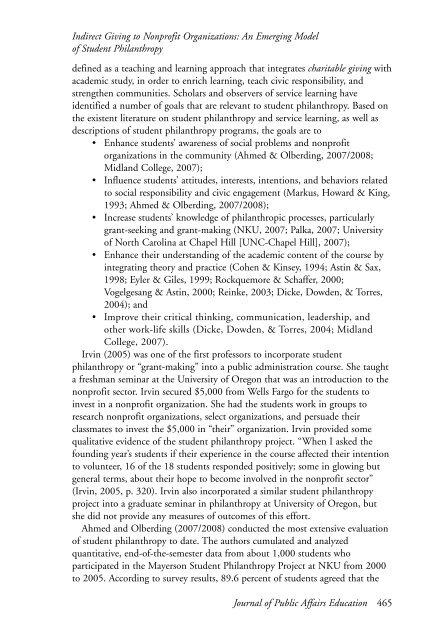JOURNAL OF PUBLIC AFFAIRS EDUCATION - National ...
JOURNAL OF PUBLIC AFFAIRS EDUCATION - National ...
JOURNAL OF PUBLIC AFFAIRS EDUCATION - National ...
Create successful ePaper yourself
Turn your PDF publications into a flip-book with our unique Google optimized e-Paper software.
Indirect Giving to Nonprofit Organizations: An Emerging Model<br />
of Student Philanthropy<br />
defined as a teaching and learning approach that integrates charitable giving with<br />
academic study, in order to enrich learning, teach civic responsibility, and<br />
strengthen communities. Scholars and observers of service learning have<br />
identified a number of goals that are relevant to student philanthropy. Based on<br />
the existent literature on student philanthropy and service learning, as well as<br />
descriptions of student philanthropy programs, the goals are to<br />
• Enhance students’ awareness of social problems and nonprofit<br />
organizations in the community (Ahmed & Olberding, 2007/2008;<br />
Midland College, 2007);<br />
• Influence students’ attitudes, interests, intentions, and behaviors related<br />
to social responsibility and civic engagement (Markus, Howard & King,<br />
1993; Ahmed & Olberding, 2007/2008);<br />
• Increase students’ knowledge of philanthropic processes, particularly<br />
grant-seeking and grant-making (NKU, 2007; Palka, 2007; University<br />
of North Carolina at Chapel Hill [UNC-Chapel Hill], 2007);<br />
• Enhance their understanding of the academic content of the course by<br />
integrating theory and practice (Cohen & Kinsey, 1994; Astin & Sax,<br />
1998; Eyler & Giles, 1999; Rockquemore & Schaffer, 2000;<br />
Vogelgesang & Astin, 2000; Reinke, 2003; Dicke, Dowden, & Torres,<br />
2004); and<br />
• Improve their critical thinking, communication, leadership, and<br />
other work-life skills (Dicke, Dowden, & Torres, 2004; Midland<br />
College, 2007).<br />
Irvin (2005) was one of the first professors to incorporate student<br />
philanthropy or “grant-making” into a public administration course. She taught<br />
a freshman seminar at the University of Oregon that was an introduction to the<br />
nonprofit sector. Irvin secured $5,000 from Wells Fargo for the students to<br />
invest in a nonprofit organization. She had the students work in groups to<br />
research nonprofit organizations, select organizations, and persuade their<br />
classmates to invest the $5,000 in “their” organization. Irvin provided some<br />
qualitative evidence of the student philanthropy project. “When I asked the<br />
founding year’s students if their experience in the course affected their intention<br />
to volunteer, 16 of the 18 students responded positively; some in glowing but<br />
general terms, about their hope to become involved in the nonprofit sector”<br />
(Irvin, 2005, p. 320). Irvin also incorporated a similar student philanthropy<br />
project into a graduate seminar in philanthropy at University of Oregon, but<br />
she did not provide any measures of outcomes of this effort.<br />
Ahmed and Olberding (2007/2008) conducted the most extensive evaluation<br />
of student philanthropy to date. The authors cumulated and analyzed<br />
quantitative, end-of-the-semester data from about 1,000 students who<br />
participated in the Mayerson Student Philanthropy Project at NKU from 2000<br />
to 2005. According to survey results, 89.6 percent of students agreed that the<br />
Journal of Public Affairs Education 465

















